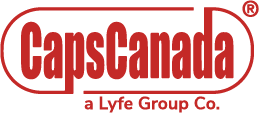Here’s a question for you: Is your product’s encapsulation complete once the two pieces of the filled capsule have been locked together?
Maybe…and maybe not.
As you may know, two piece empty capsules are designed so that once the fill material is placed into the capsule’s body, the capsule body and capsule cap lock together, thereby encapsulating the fill material. Logically speaking, it seems that once the body and cap are locked together, the product would be complete. While this is often the case, sometimes it is beneficial to add one more step to the encapsulation process: Capsule banding.
If you are working with liquid fill ingredients to create liquid capsules, capsule banding is a must.
What is capsule banding?
“Capsule banding” refers to the use of a thin, liquid strip of gelatin or HPMC to seal the joint between the body and cap of a locked capsule. This strip is applied all the way around the capsule.
Why is capsule banding required for liquid capsules?
The answer has to do with how empty capsules are designed. Regardless of the type of fill material used, air gets entrapped in the capsule during the capsule filling process. To reduce the internal pressure from this entrapped air – and avoid having that pressure cause the capsules to come apart – empty capsules are designed with tiny vents at the connection between the body and the cap, to allow this air to escape.
Without capsule banding, liquid capsules are extremely likely to have leakage problems. Capsule banding prevents this problem. After the filled liquid capsules have been allowed to rest for a specific period of time, thereby giving the air a chance to escape, the capsule banding is applied to seal these vents and prevent the liquid fill material from leaking out.
Why is capsule banding recommended for acid resistant capsules?
Acid resistant capsules such as our AR-CAPS® are designed to ensure that the capsule passes through the stomach intact. Capsule banding is recommended for use with acid resistant capsules because it serves as an additional layer of protection to ensure that the drug is not released until the capsule reaches the duodenum (i.e. the first part of the small intestine).
How is capsule banding done?
Capsule banding is done on special equipment using a banding kit. A banding kid provides all the necessary materials. In general, you’ll want to match your banding kit to the type of empty capsules used. Use a gelatin banding kit for gelatin capsules, an HPMC banding kit for HPMC capsules or our AR-CAPS® banding kit for AR-CAPS® acid resistant capsules.
Banding kits are available in clear and colored options, as well as standard and custom styles. For example, CapsCanada can create a banding kit that matches to any Pantone color, or create a custom capsule banding solution that can securely encase problematic fill materials.
Regardless of the capsule size, you’ll need 10 kg of banding solution for every 1,000,000 capsules that you produce. CapsCanada’s banding kits, which are all Kosher and Halal certified as well as free of preservatives, prions and BSE, are available in 1, 5 and 10 kg packages.
What are the benefits of capsule banding?
Capsule banding is commonly used to…
- Prevent leaks – As described above, without capsule banding, fill material can leak out of the tiny vents that are part of the standard design of empty capsules. While this is nearly always an issue for liquid capsules, depending on the specifics of the fill material, it can be a problem for powders and other dry fills as well.
- Strengthen the capsule – Capsule banding adds mechanical strength to your product, making it able to withstand more demanding environments.
- Extend your product’s shelf life – Capsule banding reduces oxidization, which in turn helps maintain your formulation’s potency for a longer period of time.
- Differentiate your product – There are many ways to visually differentiate your product, including size, color, finish, imprinting and even flavor. In the realm of color, the bodies and caps of both gelatin capsules and HPMC capsules are available in everything from clear to standard or Pantone colors. Colored capsule banding gives you the ability to add a third color to your branded look.
Having a visually recognizable product has been shown to help with dosage compliance. Many people are more likely to remember, for example, that they need to take their “blue and yellow pill with the little white band around it” than to remember the name of the medication. Having a highly-differentiated product also helps prevent counterfeiting. - Comply with requirements for tamper-evident packaging – Following a rash of drug tampering cases in the 1980s, regulations were enacted in the U.S. to ensure that over-the-counter drugs are safe from tampering. Since that time, two-piece hard capsule products have been required to have at least two different tamper-evident packaging features, such as foil seals over the bottle’s opening.
Once banded, capsules are nearly impossible to open and re-seal without leaving evidence of tampering. For this reason, capsule banding counts as a tamper-evident packaging feature.
Need to connect with an encapsulation expert?
Contact us to learn more about capsule banding, CapsCanada’s banding kits, or to discuss a custom solution that supports your unique formulation.







